线程池
1.为什么要用线程池?
这里借用《Java 并发编程的艺术》提到的来说一下使用线程池的好处:
- 降低资源消耗。通过重复利用已创建的线程降低线程创建和销毁造成的消耗。
- 提高响应速度。当任务到达时,任务可以不需要等到线程创建就能立即执行。
- 提高线程的可管理性。线程是稀缺资源,如果无限制的创建,不仅会消耗系统资源,还会降低系统的稳定性,使用线程池可以进行统一的分配,调优和监控。
2.如何创建线程池?
2.1方式一:通过ThreadPoolExecutor构造函数来创建(推荐)。
package com.young.多线程;
import java.util.concurrent.ArrayBlockingQueue;
import java.util.concurrent.Executors;
import java.util.concurrent.ThreadPoolExecutor;
import java.util.concurrent.TimeUnit;
/**
* @author 杨路恒
*/
public class ThreadPool {
public static void main(String[] args) {
ThreadPoolExecutor threadPoolExecutor = new ThreadPoolExecutor(1,2,
2, TimeUnit.MILLISECONDS,new ArrayBlockingQueue<>(2),
Executors.defaultThreadFactory(),
// new ThreadPoolExecutor.AbortPolicy()
// new ThreadPoolExecutor.CallerRunsPolicy()
// new ThreadPoolExecutor.DiscardOldestPolicy()
new ThreadPoolExecutor.DiscardPolicy()
);
threadPoolExecutor.submit(new Thread2());
threadPoolExecutor.submit(new Thread2());
threadPoolExecutor.submit(new Thread2());
threadPoolExecutor.submit(new Thread2());
threadPoolExecutor.submit(new Thread2());
threadPoolExecutor.submit(new Thread2());
threadPoolExecutor.submit(new Thread2());
threadPoolExecutor.submit(new Thread2());
threadPoolExecutor.shutdown();
}
}
参数:
/**
* Creates a new {@code ThreadPoolExecutor} with the given initial
* parameters.
*
* @param corePoolSize the number of threads to keep in the pool, even
* if they are idle, unless {@code allowCoreThreadTimeOut} is set
* @param maximumPoolSize the maximum number of threads to allow in the
* pool
* @param keepAliveTime when the number of threads is greater than
* the core, this is the maximum time that excess idle threads
* will wait for new tasks before terminating.
* @param unit the time unit for the {@code keepAliveTime} argument
* @param workQueue the queue to use for holding tasks before they are
* executed. This queue will hold only the {@code Runnable}
* tasks submitted by the {@code execute} method.
* @param threadFactory the factory to use when the executor
* creates a new thread
* @param handler the handler to use when execution is blocked
* because the thread bounds and queue capacities are reached
* @throws IllegalArgumentException if one of the following holds:<br>
* {@code corePoolSize < 0}<br>
* {@code keepAliveTime < 0}<br>
* {@code maximumPoolSize <= 0}<br>
* {@code maximumPoolSize < corePoolSize}
* @throws NullPointerException if {@code workQueue}
* or {@code threadFactory} or {@code handler} is null
*/
public ThreadPoolExecutor(int corePoolSize,
int maximumPoolSize,
long keepAliveTime,
TimeUnit unit,
BlockingQueue<Runnable> workQueue,
ThreadFactory threadFactory,
RejectedExecutionHandler handler) {
if (corePoolSize < 0 ||
maximumPoolSize <= 0 ||
maximumPoolSize < corePoolSize ||
keepAliveTime < 0)
throw new IllegalArgumentException();
if (workQueue == null || threadFactory == null || handler == null)
throw new NullPointerException();
this.acc = System.getSecurityManager() == null ?
null :
AccessController.getContext();
this.corePoolSize = corePoolSize;
this.maximumPoolSize = maximumPoolSize;
this.workQueue = workQueue;
this.keepAliveTime = unit.toNanos(keepAliveTime);
this.threadFactory = threadFactory;
this.handler = handler;
}
ThreadPoolExecutor 3 个最重要的参数:
corePoolSize: 任务队列未达到队列容量时,最大可以同时运行的线程数量。maximumPoolSize: 任务队列中存放的任务达到队列容量的时候,当前可以同时运行的线程数量变为最大线程数。workQueue: 新任务来的时候会先判断当前运行的线程数量是否达到核心线程数,如果达到的话,新任务就会被存放在队列中。
ThreadPoolExecutor其他常见参数 :
keepAliveTime:线程池中的线程数量大于corePoolSize的时候,如果这时没有新的任务提交,核心线程外的线程不会立即销毁,而是会等待,直到等待的时间超过了keepAliveTime才会被回收销毁;unit:keepAliveTime参数的时间单位。threadFactory:executor 创建新线程的时候会用到。handler:饱和策略。关于饱和策略下面单独介绍一下。
下面这张图可以加深你对线程池中各个参数的相互关系的理解(图片来源:《Java 性能调优实战》):
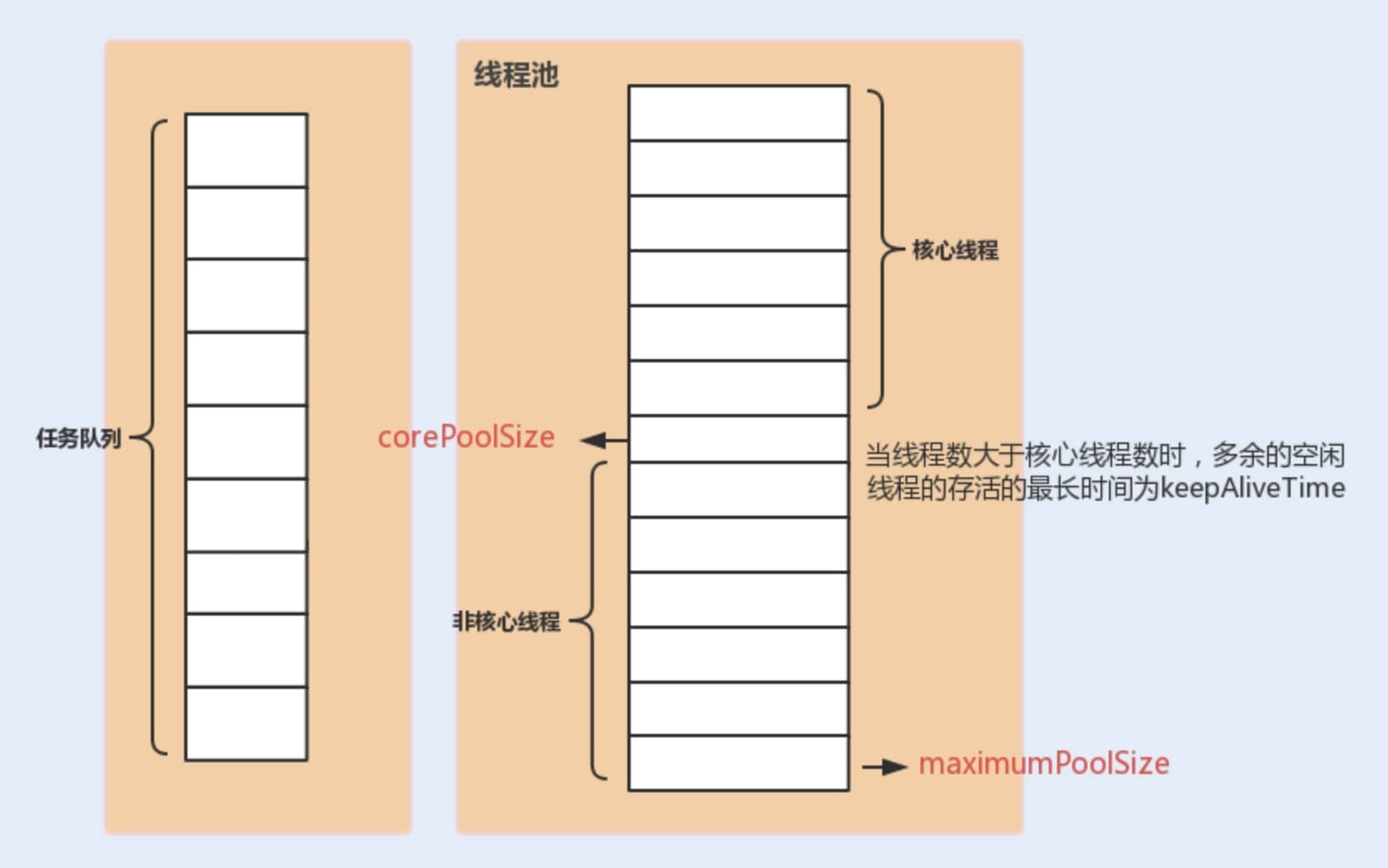
线程池的饱和策略有哪些?
如果当前同时运行的线程数量达到最大线程数量并且队列也已经被放满了任务时,ThreadPoolTaskExecutor 定义一些策略:
ThreadPoolExecutor.AbortPolicy: 抛出RejectedExecutionException来拒绝新任务的处理。ThreadPoolExecutor.CallerRunsPolicy: 调用执行自己的线程运行任务,也就是直接在调用execute方法的线程中运行(run)被拒绝的任务,如果执行程序已关闭,则会丢弃该任务。因此这种策略会降低对于新任务提交速度,影响程序的整体性能。如果您的应用程序可以承受此延迟并且你要求任何一个任务请求都要被执行的话,你可以选择这个策略。ThreadPoolExecutor.DiscardPolicy: 不处理新任务,直接丢弃掉。ThreadPoolExecutor.DiscardOldestPolicy: 此策略将丢弃最早的未处理的任务请求。
举个例子:Spring 通过 ThreadPoolTaskExecutor 或者我们直接通过 ThreadPoolExecutor 的构造函数创建线程池的时候,当我们不指定 RejectedExecutionHandler 饱和策略来配置线程池的时候,默认使用的是 AbortPolicy。在这种饱和策略下,如果队列满了,ThreadPoolExecutor 将抛出 RejectedExecutionException 异常来拒绝新来的任务 ,这代表你将丢失对这个任务的处理。如果不想丢弃任务的话,可以使用CallerRunsPolicy。CallerRunsPolicy 和其他的几个策略不同,它既不会抛弃任务,也不会抛出异常,而是将任务回退给调用者,使用调用者的线程来执行任务。
线程池常用的阻塞队列有哪些?
新任务来的时候会先判断当前运行的线程数量是否达到核心线程数,如果达到的话,新任务就会被存放在队列中。
不同的线程池会选用不同的阻塞队列,我们可以结合内置线程池来分析。
- 容量为
Integer.MAX_VALUE的LinkedBlockingQueue(无界队列):FixedThreadPool和SingleThreadExector。由于队列永远不会被放满,因此FixedThreadPool最多只能创建核心线程数的线程。 SynchronousQueue(同步队列) :CachedThreadPool。SynchronousQueue没有容量,不存储元素,目的是保证对于提交的任务,如果有空闲线程,则使用空闲线程来处理;否则新建一个线程来处理任务。也就是说,CachedThreadPool的最大线程数是Integer.MAX_VALUE,可以理解为线程数是可以无限扩展的,可能会创建大量线程,从而导致 OOM。DelayedWorkQueue(延迟阻塞队列):ScheduledThreadPool和SingleThreadScheduledExecutor。DelayedWorkQueue的内部元素并不是按照放入的时间排序,而是会按照延迟的时间长短对任务进行排序,内部采用的是“堆”的数据结构,可以保证每次出队的任务都是当前队列中执行时间最靠前的。DelayedWorkQueue添加元素满了之后会自动扩容原来容量的 1/2,即永远不会阻塞,最大扩容可达Integer.MAX_VALUE,所以最多只能创建核心线程数的线程。
线程池处理任务的流程了解吗?
- 如果当前运行的线程数小于核心线程数,那么就会新建一个线程来执行任务。
- 如果当前运行的线程数等于或大于核心线程数,但是小于最大线程数,那么就把该任务放入到任务队列里等待执行。
- 如果向任务队列投放任务失败(任务队列已经满了),但是当前运行的线程数是小于最大线程数的,就新建一个线程来执行任务。
- 如果当前运行的线程数已经等同于最大线程数了,新建线程将会使当前运行的线程超出最大线程数,那么当前任务会被拒绝,饱和策略会调用
RejectedExecutionHandler.rejectedExecution()方法。
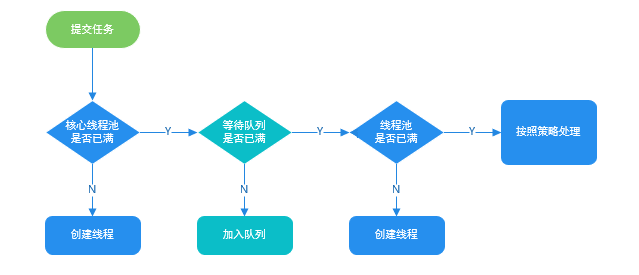
其实java线程池的实现原理很简单,说白了就是一个线程集合workerSet和一个阻塞队列workQueue。当用户向线程池提交一个任务(也就是线程)时,线程池会先将任务放入workQueue中。workerSet中的线程会不断的从workQueue中获取线程然后执行。当workQueue中没有任务的时候,worker就会阻塞,直到队列中有任务了就取出来继续执行。
任务的执行
execute –> addWorker –>runworker (getTask)
关闭线程池:
遍历线程池中的所有线程,然后逐个调用线程的interrupt方法来中断线程。
- 关闭方式 - shutdown
将线程池里的线程状态设置成SHUTDOWN状态, 然后中断所有没有正在执行任务的线程。
- 关闭方式 - shutdownNow
将线程池里的线程状态设置成STOP状态, 然后停止所有正在执行或暂停任务的线程。只要调用这两个关闭方法中的任意一个, isShutDown() 返回true.。当所有任务都成功关闭了, isTerminated()返回true。
如何设定线程池的大小?
有一个简单并且适用面比较广的公式:
- CPU 密集型任务(N+1): 这种任务消耗的主要是 CPU 资源,可以将线程数设置为 N(CPU 核心数)+1。比 CPU 核心数多出来的一个线程是为了防止线程偶发的缺页中断,或者其它原因导致的任务暂停而带来的影响。一旦任务暂停,CPU 就会处于空闲状态,而在这种情况下多出来的一个线程就可以充分利用 CPU 的空闲时间。
- I/O 密集型任务(2N): 这种任务应用起来,系统会用大部分的时间来处理 I/O 交互,而线程在处理 I/O 的时间段内不会占用 CPU 来处理,这时就可以将 CPU 交出给其它线程使用。因此在 I/O 密集型任务的应用中,我们可以多配置一些线程,具体的计算方法是 2N。
2.2方式二:通过 Executor 框架的工具类 Executors 来创建。
我们可以创建多种类型的 ThreadPoolExecutor:
FixedThreadPool: 该方法返回一个固定线程数量的线程池。该线程池中的线程数量始终不变。当有一个新的任务提交时,线程池中若有空闲线程,则立即执行。若没有,则新的任务会被暂存在一个任务队列中,待有线程空闲时,便处理在任务队列中的任务。SingleThreadExecutor: 该方法返回一个只有一个线程的线程池。若多余一个任务被提交到该线程池,任务会被保存在一个任务队列中,待线程空闲,按先入先出的顺序执行队列中的任务。CachedThreadPool: 该方法返回一个可根据实际情况调整线程数量的线程池。线程池的线程数量不确定,但若有空闲线程可以复用,则会优先使用可复用的线程。若所有线程均在工作,又有新的任务提交,则会创建新的线程处理任务。所有线程在当前任务执行完毕后,将返回线程池进行复用。ScheduledThreadPool:该返回一个用来在给定的延迟后运行任务或者定期执行任务的线程池。
3.为什么不推荐使用内置线程池?
在《阿里巴巴 Java 开发手册》“并发处理”这一章节,明确指出线程资源必须通过线程池提供,不允许在应用中自行显式创建线程。
为什么呢?
使用线程池的好处是减少在创建和销毁线程上所消耗的时间以及系统资源开销,解决资源不足的问题。如果不使用线程池,有可能会造成系统创建大量同类线程而导致消耗完内存或者“过度切换”的问题。
另外,《阿里巴巴 Java 开发手册》中强制线程池不允许使用 Executors 去创建,而是通过 ThreadPoolExecutor 构造函数的方式,这样的处理方式让写的同学更加明确线程池的运行规则,规避资源耗尽的风险。
Executors 返回线程池对象的弊端如下(后文会详细介绍到):
FixedThreadPool和SingleThreadExecutor: 使用的是无界的LinkedBlockingQueue,任务队列最大长度为Integer.MAX_VALUE,可能堆积大量的请求,从而导致 OOM。CachedThreadPool:使用的是同步队列SynchronousQueue, 允许创建的线程数量为Integer.MAX_VALUE,可能会创建大量线程,从而导致 OOM。ScheduledThreadPool和SingleThreadScheduledExecutor: 使用的无界的延迟阻塞队列DelayedWorkQueue,任务队列最大长度为Integer.MAX_VALUE,可能堆积大量的请求,从而导致 OOM。
4.如何动态修改线程池的参数?
JDK原生线程池ThreadPoolExecutor提供了如下几个public的setter方法,如下图所示:

重点是基于这几个public方法,我们只需要维护ThreadPoolExecutor的实例,并且在需要修改的时候拿到实例修改其参数即可。
问题一:线程池被创建后里面有线程吗?如果没有的话,你知道有什么方法对线程池进行预热吗?
线程池被创建后如果没有任务过来,里面是不会有线程的。如果需要预热的话可以调用下面的两个方法:
全部启动:
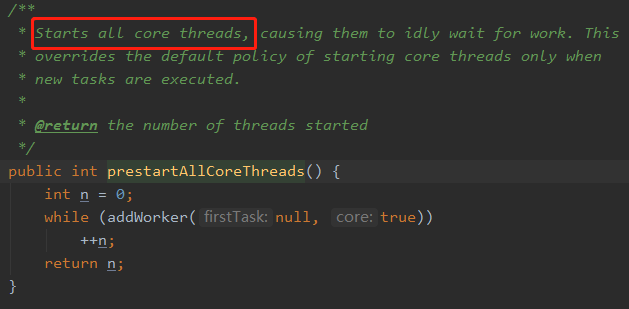
仅启动一个:
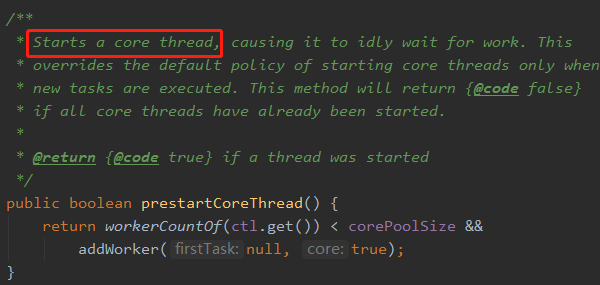
问题二:核心线程数会被回收吗?需要什么设置?
核心线程数默认是不会被回收的,如果需要回收核心线程数,需要调用下面的方法:
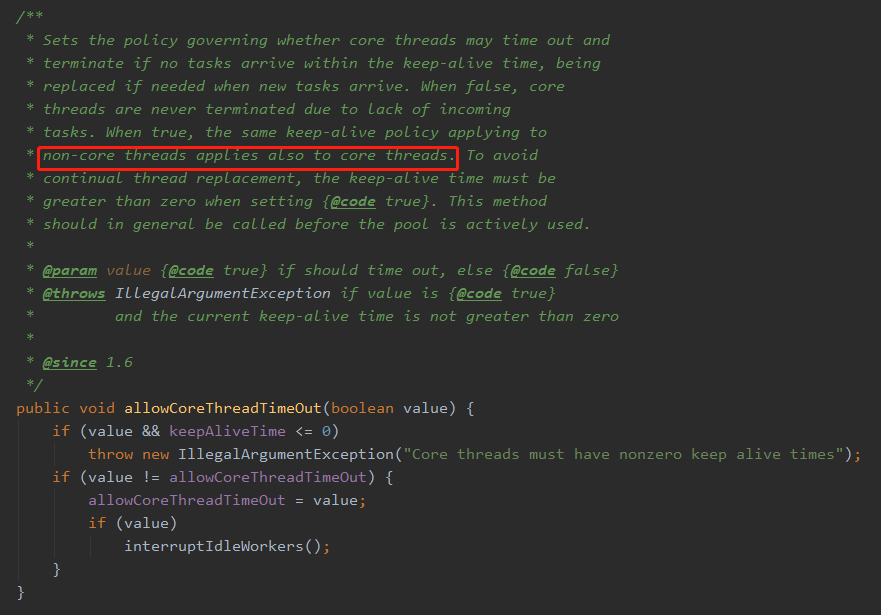
5.监控线程池的状态
可以使用ThreadPoolExecutor以下方法:
getTaskCount()Returns the approximate total number of tasks that have ever been scheduled for execution.getCompletedTaskCount()Returns the approximate total number of tasks that have completed execution. 返回结果少于getTaskCount()。getLargestPoolSize()Returns the largest number of threads that have ever simultaneously been in the pool. 返回结果小于等于maximumPoolSizegetPoolSize()Returns the current number of threads in the pool.getActiveCount()Returns the approximate number of threads that are actively executing tasks